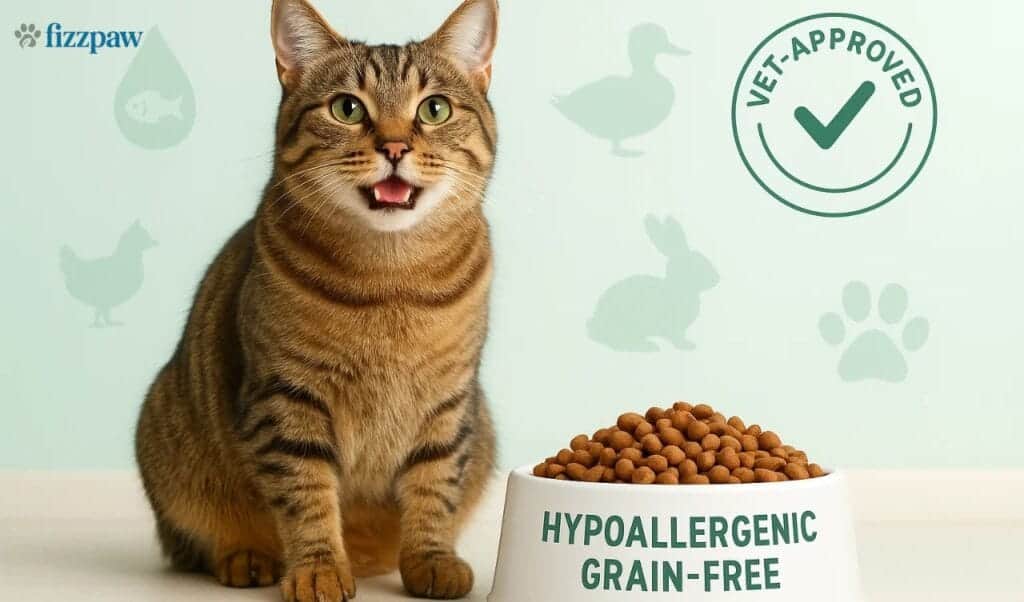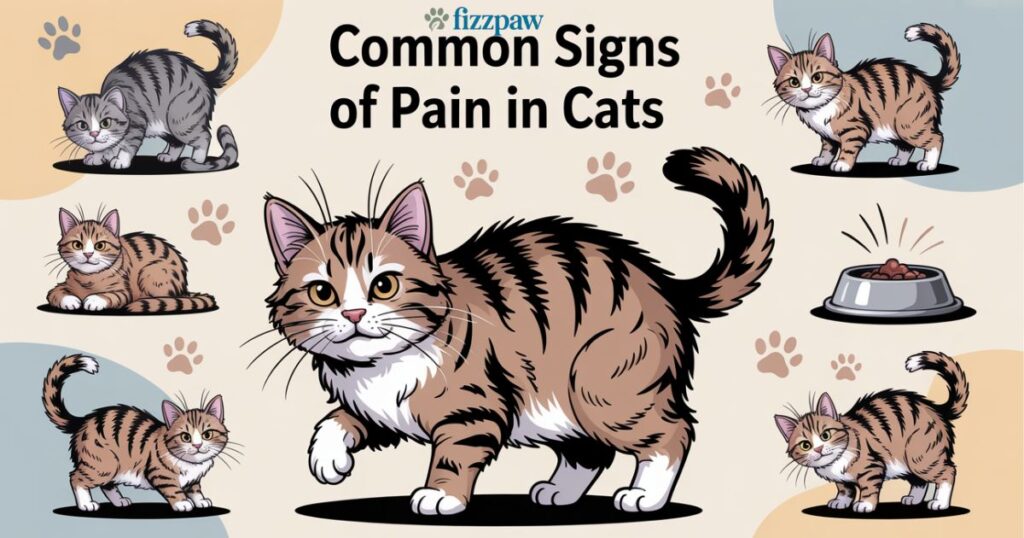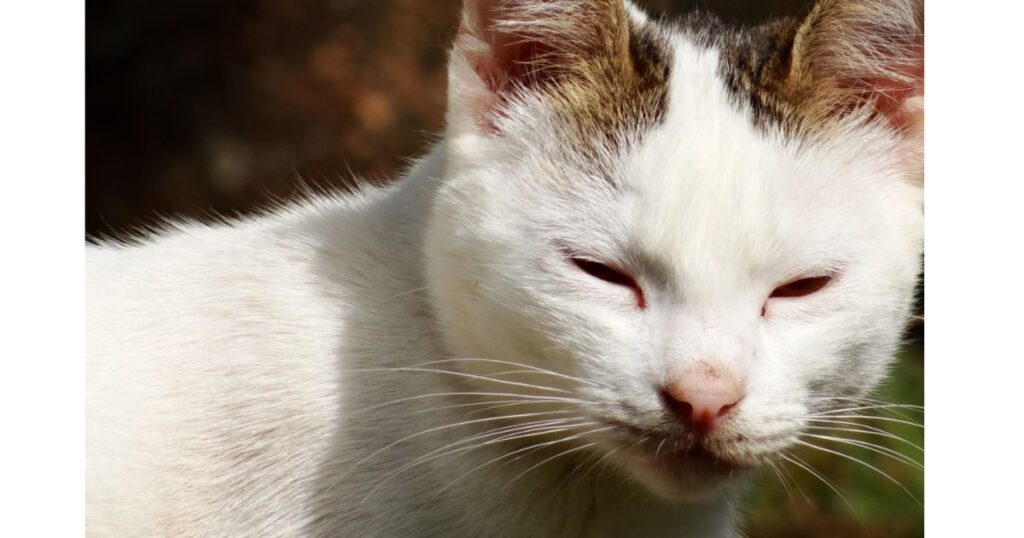If your cat is constantly scratching or suffering from irritated skin, cat food for skin allergies may be the solution. Many cats experience food allergies in cats, which can lead to conditions like itchy skin in cats or feline skin rash. Learn more about how to soothe my cat’s itchy skin to provide immediate relief.
These allergies are frequently due to certain proteins or grains that are in their food. The cause can be hard to pin down, but handling these allergies the right way ameliorates the issue. Whether that means finding the best hydrolyzed protein cat food or the best novel protein cat food, it is very important that you find the best food that is right for your cat specifically.
In this guide, you’ll learn what causes skin allergies in cats, how to spot the signs, and what vet-recommended steps you can take to help your cat feel better.
What Causes Skin Allergies in Cats?
Cat skin allergies are caused by many things. Food allergies, environmental allergens, and flea infestations are the most likely causes. In cats, food allergies usually extends to proteins such as chicken and beef and environmental allergens might be dust, mold, pollen, and even a flea bite.
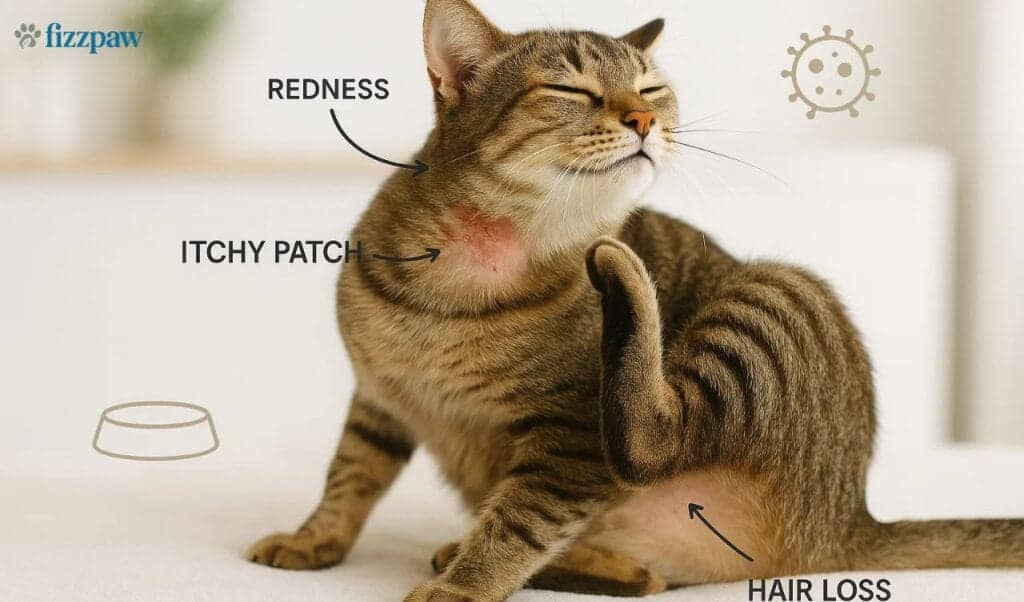
When a cat is allergic to something, their immune system will overreact, leading to symptoms like itchy skin in cats, rashes or hair loss. These allergies happen because the body confuses harmless substances as harmful, threatening agents, which in turn trigger our immune system to produce inflammation in the skin.
Key Causes of Skin Allergies in Cats:
- Food Allergies: Usually triggered by proteins like chicken, beef, and grains.
- Environmental Allergens: These include dust, mold, pollen, and other pollutants.
- Flea Infestation: Flea saliva can cause itching and rashes.
- Genetics: Some cats are genetically more prone to developing allergies.
It is very important to know what is causing skin allergies in cats when choosing a treatment for the same.
Common Signs That Your Cat Has a Skin Allergy
These are the symptoms you may observe on your feline if it is plagued with skin allergies. These symptoms can be mild or intense and can impact everything from your cat’s behavior to its overall personality.
Common Symptoms of Skin Allergies in Cats:
- Itchy Skin in Cats: Excessive scratching, licking, or biting.
- Red Spots on Cat Skin: Small, irritated patches or bumps.
- Flaky or Scaly Skin on Cats: Dry, flaky skin that may result in hair loss.
- Crusty Scabs on Cats: These can form as a result of frequent scratching.
- Feline Skin Rash: Patches of inflamed or irritated skin.
- Hives or Swelling: Raised, red areas of skin.
It is very important to get your cat to the vet if you notice these signs. Early identification and management reduces the possibility of the allergy getting worse.
Is Your Cat’s Food the Real Culprit?
In some cases, a cat’s diet may account for the primary source of a cat’s allergic dermatitis. If you notice that your cat’s skin problems get worse when she eats certain foods, a food allergy could be the cause. Protein intolerance vs allergy can be difficult to distinguish, but a food allergy is typically associated with a specific protein in the diet, such as chicken, beef or fish.
Similarly, if your cat has an allergy to a certain type of cat food, transitioning to a novel protein diet for cats (for example, duck cat food or rabbit cat food) might be an effective solution. These types of proteins are gentler on your cat’s system and are less likely to trigger allergic reactions.
Signs that food might be the issue:
- Red, inflamed skin after eating
- Vomiting or diarrhea in addition to skin irritation
- Change in coat condition (dull, thinning fur)
A change in diet to the proper cat food for allergies can greatly enhance the overall skin health of your pet.
How Vets Diagnose Cat Food Allergies
A cat skin allergy can be difficult to diagnose. A veterinarian will probably begin by eliminating alternative reasons such as a flea infestation or environmental allergens. There are numerous ways to diagnose this condition, and one is the skin scraping in cats to find if the cat has an infection or its coat has a certain condition.
An elimination diet trial is another way to help identify food allergies. In this test, the cat receives a restricted ingredient diet for a few weeks that contains a new type of protein and a check is done to see if the symptoms gradually resolve.
- Steps to diagnose a food allergy:
- Physical exam and skin scraping in cats to rule out infections
- An elimination diet involves feeding your cat hydrolyzed protein food or a novel protein diet for cats
- Allergy tests for more severe cases
- Physical exam and skin scraping in cats to rule out infections
Veterinarians may also prescribe allergy shots for cats, or immunotherapy for cats, if your cat’s allergies are severe or chronic.
Best Types of Cat Food for Skin Allergies
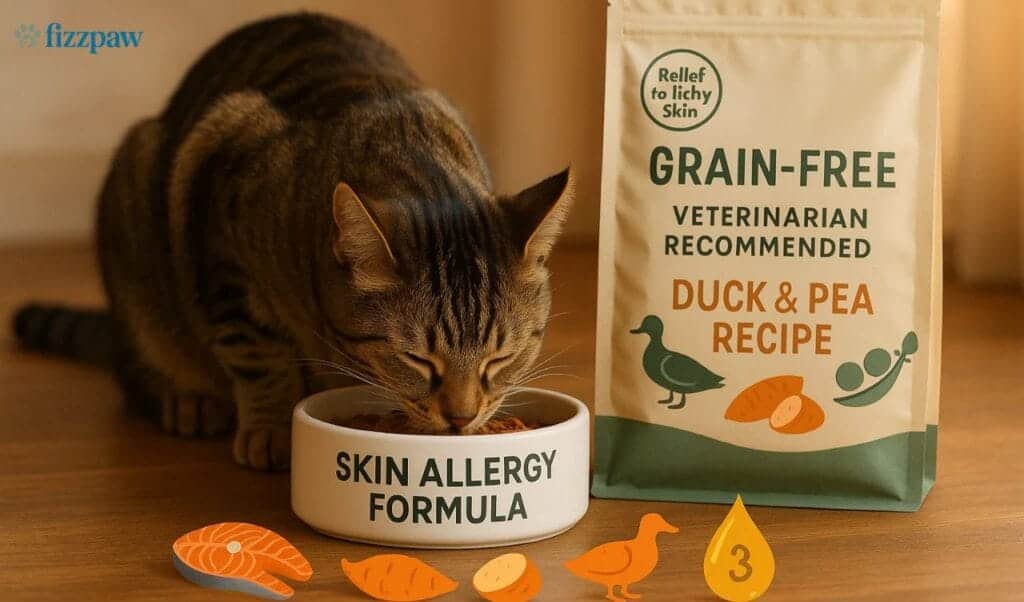
When it comes to cat food allergies, it is important to find the best cat food for sensitive skin. Some foods are specifically formulated to reduce allergic reactions, like grain-free cat food or hydrolyzed protein cat food. These foods help to reduce contact with common allergy-inducers, such as grains or beef, that can be the cause of skin irritation.
Some of the best types of cat food for skin allergies include:
- Grain-free cat food: Reduces the risk of gluten or grain sensitivities
- Hydrolyzed protein cat food: Breaks down proteins into smaller components to reduce allergic reactions
- Limited ingredient cat food: Contains fewer ingredients, making it easier to identify allergens
- Novel protein diet for cats: Includes proteins like duck or rabbit, which are less likely to trigger allergies
Best Food for Cats with Skin Allergies (Table)
| Food Type | Description | Benefits |
| Grain-Free Cat Food | Food without grains like wheat or corn. | Reduces allergic reactions to grains |
| Hydrolyzed Protein Cat Food | Protein is broken down into smaller pieces. | Reduces immune system response |
| Limited Ingredient Cat Food | Contains only a few, simple ingredients. | Eases digestion and allergy testing |
| Novel Protein Diet for Cats | Includes proteins like duck or rabbit. | Less likely to trigger allergies |
Natural Remedies for Managing Cat Skin Allergies
Here are a few ways to soothe your cat’s irritable skin with natural treatments. As someone who’s battled cat skin allergies before, there are lots of cures that can put an end to your cat’s suffering, and they involve more than simple diet changes. Omega-3 for cats (as found in fish oils) can help reduce inflammation and support healthier skin. Omega-6 fatty acids are also a crucial source of nourishment in your cat’s skin and coat.
- Natural remedies for skin allergies:
- Omega-3 for cats: Reduces skin inflammation and promotes a shiny coat.
- Coconut oil: Can help soothe dry, itchy patches.
- Aloe vera: Soothes irritated skin and reduces redness.
- Omega-3 for cats: Reduces skin inflammation and promotes a shiny coat.
Topical Treatment for Cat Skin (Checklist)
- Aloe vera gel (for localized irritation)
- Fish oil (for internal use and coat health)
- Coconut oil (to apply to affected areas)
Vet-Recommended Cat Food Brands for Allergy Relief
Veterinary Approved Allergy Cat Food Brands. Some of the best allergy cat food options are highly recommended by veterinarians since they are specifically created for treating food allergies in cats and in accordance with their high-quality standards. Here are some brands that offer diets formulated to minimize allergic responses:
- Hill’s Prescription Diet: Known for its hydrolyzed protein cat food and limited ingredient cat food options.
- Royal Canin: Offers novel protein diet for cats and grain-free cat food options.
- Purina Pro Plan Veterinary Diets: Contains highly digestible proteins and omega-3 fatty acids.
How to Safely Transition Your Cat to a New Diet
Switching your cat to a new diet should be a gradual process to prevent an upset tummy. Begin by adding a little of the new food and the rest of the old food together and slowly increasing the ratio over the course of a week.
- Transition steps:
- Start with 25% new food, 75% old food.
- Increase to 50/50 after a few days.
- Move to 75% new food after a week.
- Full transition to the new food after 10-14 days.
- Start with 25% new food, 75% old food.
Slow transitions can help prevent gastrointestinal tract reactions and give your cat time to adjust.
Should You Try Homemade or Raw Diets for Your Cat’s Skin Allergy?
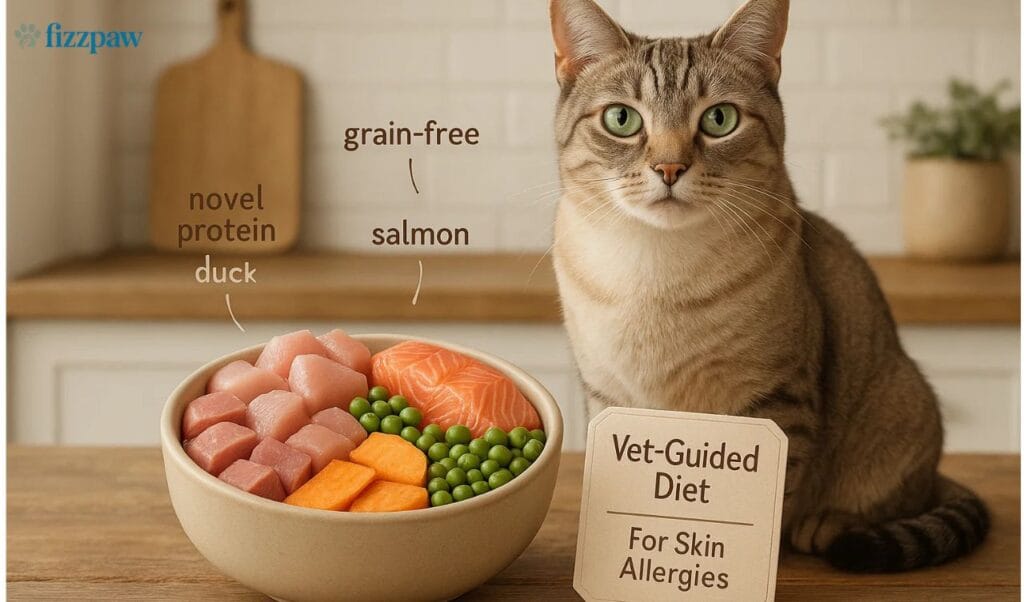
Home-made or raw diets are frequently seen as an option to commercial cat food, whether in order to address cat food allergies or on the whole. But these diets must be well balanced, as an improperly mixed, home-made diet may cause nutrient imbalances. Duck or rabbit cat food might be good choices in homemade diets for cats with food allergies.
- Pros of homemade or raw diets:
- Control over ingredients
- Fewer allergens
- Control over ingredients
- Cons:
- Risk of nutritional deficiencies
- Time-consuming to prepare
Nutritional Add-Ons That Help With Skin Health
In addition to selecting the proper food, there may be some nutritional add-ons that could help improve your cat’s skin health. Some of the omega 3s in fish oil or found in flaxseed can help to calm irritated skin, and decrease inflammation. Probiotics may also help to maintain a healthy gut, which may decrease food allergies.
When to See a Vet About Your Cat’s Skin Allergy
If your cat’s skin issues aren’t soothed through diet changes, it’s time to have him evaluated by a vet. If you notice long-lasting crusty scabs on a cat or red bumps on cat skin, it may be just the beginning of serious underlying conditions. A vet can do tests and suggest a treatment.
Conclusion: Managing Your Cat’s Skin Allergies Through Diet and Care
In summary, cat skin allergies can be controlled with diet changes and care. You can easily improve your cat’s health but using the correct cat food for skin allergies and a combination of the right supplements. Hydrolyzed protein cat food, grain-free cat food and limited ingredient diet for cats all make great options for allergies.
FAQs
1. What causes skin allergies in cats?
Cats may have a skin allergy due to food allergy, environmental allergens such as dust or pollen or a flea infestation.
2. How do I know if my cat has a food allergy?
Watch for signs such as scratching or itching, flaky skin, red spots or upset stomach after meals.
3. Can I switch my cat to a homemade diet for skin allergies?
Homemade diets can work, but they must be nutritionally balanced to avoid deficiencies.
4. How can I help my cat’s skin allergies naturally?
Try adding omega-3 fatty acids to your cat’s diet and using coconut oil on affected areas.
5. When should I see a vet about my cat’s skin allergy?
If your cat’s symptoms worsen or continue despite diet changes, it’s time to seek a vet’s care.

